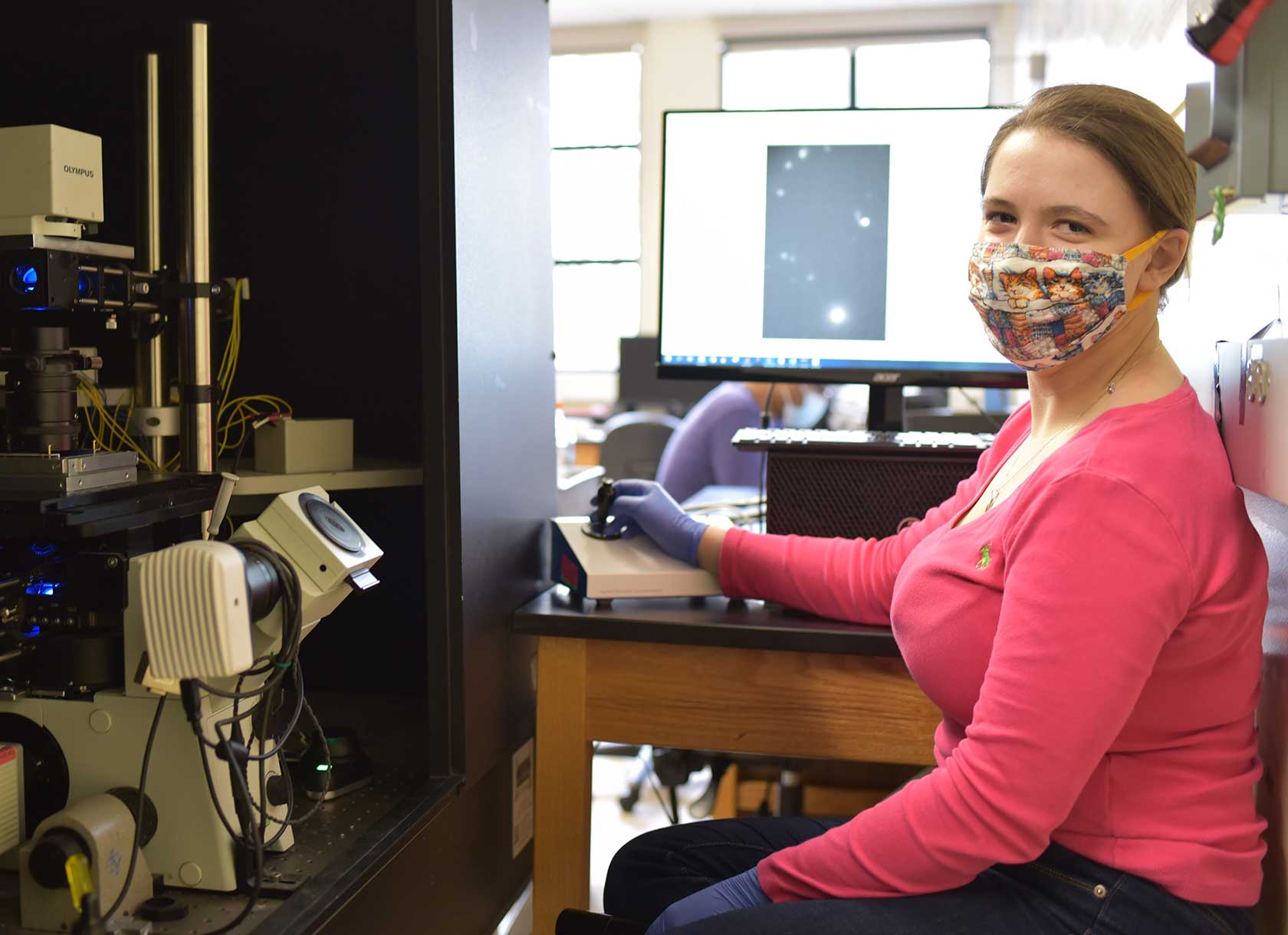By Ella Murdock Gardner ’22

For physics and math double major Daisy Achiriloaie ’24, co-authoring a research paper in experimental biophysics during her first year at Scripps was only the beginning. This semester, she’s not only publishing her own research in Nature Communications and building a custom light sheet microscope for the W.M. Keck Science Department, but she has also been awarded the most prestigious scholarship in the United States for undergraduates studying natural science, engineering, or math: the Barry Goldwater Scholarship.
Last summer, Achiriloaie worked with Assistant Professor of Physics Janet Sheung to study the mechanical properties of an in vitro system of filaments that form the basic building blocks of the cellular cytoskeleton. Cells are viscoelastic, meaning that they have the properties of both solids and liquids. Because of this trait, they can actively tune their physical properties to become more rigid or more malleable in response to their environment.
“It’s interesting to study why materials like the cytoskeleton have these physical properties,” says Achiriloaie. “But another exciting aspect of the research is trying to employ these properties to design new materials that can drive themselves out of equilibrium and change their physical properties over time.”
In their first set of experiments, Achiriloaie and Sheung studied how the addition of the motor protein muscle myosin II would change the mechanical properties of an actin-microtubule composite network. They found that the myosin—which attaches to the actin filaments and slides them against each other— makes the network four orders of magnitude stiffer as the myosin causes large-scale contraction. “At first we thought there was a bug in the code, or I multiplied something by four orders of magnitude somewhere, but I kept checking it and it was a real result,” says Achiriloaie.
Achiriloaie’s and Sheung’s research on this topic was ultimately published in the journal American Chemical Society Macro Letters last fall. But Achiriloaie didn’t stop there. She transitioned into testing how the dynamics of the filament system change when you add two active agents: myosin and kinesin.
Within a cell, kinesin, another motor protein, transports cellular cargo along microtubules to specific locations across the cell. “Kinesin essentially has two “legs,” and it walks across the filament like a track carrying its cargo,” Achiriloaie says, demonstrating by walking her fingers along the table. “In the lab, instead of attaching the kinesin to a cargo, you can attach it head-to-head with another kinesin. This kinesin cluster will walk along adjacent filaments, generating a sliding motion.”
Through her analysis, Achiriloaie found some novel results: When you combine the myosin and the kinesin, competition between these two molecular motors delays the onset of rapid motion within the system. “To my knowledge, nobody has experimentally studied a cytoskeleton system driven by two motors, so synergistic effects—like the delayed onset of motion—represent somewhat new territory in the study of active systems,” she says. Achiriloaie is the first author of a research paper detailing these results, which will be published in the scientific journal Nature Communications in the coming months.
During the pandemic, Achiriloaie performed these experiments in Sheung’s collaborator Rae Robertson-Anderson’s lab at the University of San Diego (USD), using an imaging technique called confocal microscopy to measure the dynamics of these systems. This involved fluorescently labeling parts of her network and using USD’s confocal microscope to take a kind of stop-motion video of her system in a single plane, allowing her to quantify dynamics like velocity. Right now, Achiriloaie is working to custom build a more sophisticated light sheet microscope here at Scripps that will allow her to observe the motion of light-sensitive particles through active cytoskeleton networks.
“Like a confocal microscope, a light sheet microscope only images a single plane of a sample,” says Achiriloaie. “But unlike the confocal, it uses cylindrical lenses to only illuminate a single plane. The particles we’re studying are sensitive to photobleaching, so the light sheet microscope is a lot gentler, allowing us to image a system for a longer period of time.” Eventually, Achiriloaie and Sheung hope to add an optical trap (a highly focused laser beam that holds microscopic particles in place) to the microscope, making it the first instrument of its kind.
The latest addition to Achiriloaie’s ever-growing list of scientific accomplishments is winning the prestigious Goldwater Scholarship this semester. From an estimated pool of over 5,000 applicants, a total of 417 college students from across the country were selected for this honor. In her application for the scholarship, Achiriloaie articulated her ambition to study fluid dynamics in graduate school. “It’s always been my dream to be a physics professor,” Achiriloaie says. “Eventually, I want to run my own experimental physics lab.” Given her many contributions to the field during her first two years at Scripps, it’s safe to say she’s well on her way.

